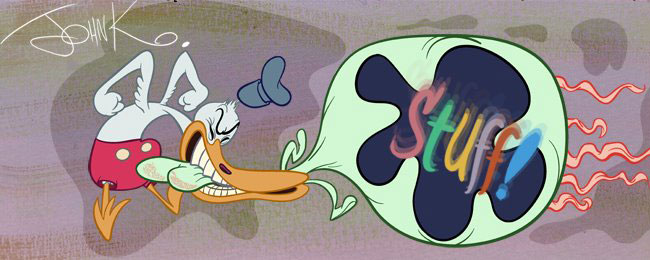 Harvey's compositions are more mathematically careful than Kelly's, but his details in BG elements are more conservative or "realistic" than Kelly's.
Harvey's compositions are more mathematically careful than Kelly's, but his details in BG elements are more conservative or "realistic" than Kelly's.
 Eisenberg's characters are more solidly constructed. Constructed totally out of cartoon forms - pears and spheres.
Eisenberg's characters are more solidly constructed. Constructed totally out of cartoon forms - pears and spheres.All the details fit snugly and in their perfect hierarchical place on the larger simpler forms.
 Kelly's construction is not so tight.
Kelly's construction is not so tight.  The features on his characters tend to float around.
The features on his characters tend to float around.On the other hand, he mixes in suggestions of actual anatomical forms. The mouse above has a skeleton, not just a line of action supporting him.
The dog below has suggestions of actual dog anatomy: his wrists, his spine

 Eisenberg can draw elaborate BGs and in any perspective. His panels tend to be a lot more dynamic than Kelly's. - or anyone else's.
Eisenberg can draw elaborate BGs and in any perspective. His panels tend to be a lot more dynamic than Kelly's. - or anyone else's. Kelly tends to keep his characters staged left to right and is not as comfortable with perspective.
Kelly tends to keep his characters staged left to right and is not as comfortable with perspective.
Both cartoonists use lines of action and opposing poses from their animation training, but Kelly's tend to be more subtle, His characters are more straight up and down. The principles are still there, but toned down. This is great if you can do it. Later cartoonists who might have admired Kelly could easily miss this aspect of his work and really eliminate any lines of action and opposing poses completely - as most cartoons and comics today.
 Subtlety is good, but tends to lead to a next generation of blandness.
Subtlety is good, but tends to lead to a next generation of blandness. The whole cartoon business by the 50s toned down it's earlier dynamic style in favor of characters who merely walk and talk. When the next generation of cartoonists grew up on these cartoons, they assumed that you don't need any poses at all and everything from then on was walking and talking and straight up and down characters.
The whole cartoon business by the 50s toned down it's earlier dynamic style in favor of characters who merely walk and talk. When the next generation of cartoonists grew up on these cartoons, they assumed that you don't need any poses at all and everything from then on was walking and talking and straight up and down characters.
Kelly is obviously capable of more dynamic posing and when his stories call for it, he does it - as in the page above.

Kelly also dabbles in soft little character scenarios like the page above. This is so Chuck Jones! Little cute bits of business between ignorant animals. Even the design of the characters is very Jones/Cannon early 40s. Right down to the loose construction. I wonder who influenced who.

Eisenberg, schooled by Joe Barbera on Tom and Jerry doesn't get into character so much and so focuses his creativity more on technical aspects of comic layout, dynamics, graphic page flow and strong character posing.
Kelly's characters are cuter - they have bigger eyes and pupils. For some reason, Harvey draws tiny little eyes which takes away some of the cartooniness and fun. McKimson did that too.
Both these cartoonists are top talents and have 90% of their approach in common. The 10% or so where they vary is where their personal styles happen.
On the surface the 2 styles look very different, but a lot of the appeal of both styles is that they have such great drawing skill supporting the individual differences.
 A lot of Kelly's style is in his inking. The drawings themselves don't deviate much from standard 40s cartoon style, but the finish really grabs your attention and seals the deal.
A lot of Kelly's style is in his inking. The drawings themselves don't deviate much from standard 40s cartoon style, but the finish really grabs your attention and seals the deal.
A lot of the appeal of any skill is the skill itself. Just the fact that someone can do something technically amazing- that most of humanity can't is entertaining. That's why there is such a big audience for the Olympics of for UFC. Each athlete may have his own own personal style, but if he doesn't win then it didn't do him much good.
This aspect of technical virtuosity is missing from today's popular entertainment, yet I meet plenty of cartoonists who think they have "a style" and want to be judged on their individuality. Usually this style is just a collection of ignorant mistakes or a superficial imitation of the latest decadent trend in executive-pleasing cartoons.
EISENBERG KEPT 40S PRINCIPLES ALIVE EVEN INTO THE 60S
 By the 1960s most cartoons had become really stiff. Eisenberg's posing retained the line of action and opposing poses of classic cartoons.
By the 1960s most cartoons had become really stiff. Eisenberg's posing retained the line of action and opposing poses of classic cartoons. The poses are more subtle in these comics, but still show extreme knowledge and control.
The poses are more subtle in these comics, but still show extreme knowledge and control.


